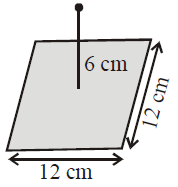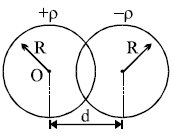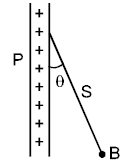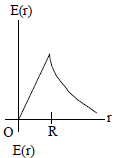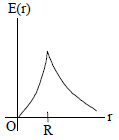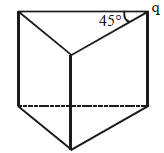Question 5: The electric field in a region is give n by \[ \overrightarrow{E}=200\hat{i}N/C for x > 0 and -200\hat{i}N/C for x < 0 \]
A closed cylinder of length 2m and
cross -section area 10² m² is kept in such away that the axis of cylinder is along X-axis and its centre coincides with origin. The total charge inside the cylinder is
(Take \(e_{0}=8.85\times 10^{-12} C^{2}m^{2}N)\)
\[ 1.77\times 10^{-11}C\]
View Solution
Solution:
To calculate the total charge inside the cylinder, we use Gauss's law:
\[
\Phi_E = \frac{q_{\text{inside}}}{\epsilon_0}
\]
Here:
- \(\Phi_E\) is the total electric flux through the surface of the cylinder,
- \(q_{\text{inside}}\) is the total charge enclosed by the cylinder,
- \(\epsilon_0 = 8.85 \times 10^{-12} \, \text{C}^2/(\text{N·m}^2)\).
Step 1: Electric flux through the cylinder
The cylinder has two flat faces (at \(x = +1\) m and \(x = -1\) m) and a curved surface. The electric field is parallel to the axis, so the flux through the curved surface is **zero**. Thus, only the two flat faces contribute to the flux.
- For the face at \(x = +1\) m:
\(\Phi_E^+ = E \cdot A = 200 \cdot 10^{-2} = 2 \, \text{N·m}^2/\text{C}\),
- For the face at \(x = -1\) m:
\(\Phi_E^- = E \cdot A = -200 \cdot 10^{-2} = -2 \, \text{N·m}^2/\text{C}\).
The total flux is:
\[
\Phi_E = \Phi_E^+ + \Phi_E^- = 2 - (-2) = 4 \, \text{N·m}^2/\text{C}
\]
Step 2: Total charge inside the cylinder
Using Gauss's law:
\[
q_{\text{inside}} = \Phi_E \cdot \epsilon_0 = 4 \cdot (8.85 \times 10^{-12})
\]
Simplify:
\[
q_{\text{inside}} = 35.4 \times 10^{-8} \, \text{C}
\]
Thus, the total charge inside the cylinder is:
\[
{35.4 \times 10^{-8} \, \text{C}}
\]
Discuss this question


